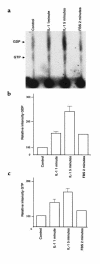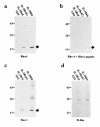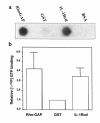The IL-1 receptor and Rho directly associate to drive cell activation in inflammation
- PMID: 10359565
- PMCID: PMC408367
- DOI: 10.1172/JCI5754
The IL-1 receptor and Rho directly associate to drive cell activation in inflammation
Abstract
IL-1-stimulated mesenchymal cells model molecular mechanisms of inflammation. Binding of IL-1 to the type I IL-1 receptor (IL-1R) clusters a multi-subunit signaling complex at focal adhesion complexes. Since Rho family GTPases coordinately organize actin cytoskeleton and signaling to regulate cell phenotype, we hypothesized that the IL-1R signaling complex contained these G proteins. IL-1 stimulated actin stress fiber formation in serum-starved HeLa cells in a Rho-dependent manner and rapidly activated nucleotide exchange on RhoA. Glutathione S-transferase (GST) fusion proteins, containing either the full-length IL-1R cytosolic domain (GST-IL-1Rcd) or the terminal 68 amino acids of IL-1R required for IL-1-dependent signal transduction, specifically coprecipitated both RhoA and Rac-1, but not p21(ras), from Triton-soluble HeLa cell extracts. In whole cells, a small-molecular-weight G protein coimmunoprecipitated by anti-IL-1R antibody was a substrate for C3 transferase, which specifically ADP-ribosylates Rho GTPases. Constitutively activated RhoA, loaded with [gamma-32P]GTP, directly interacted with GST-IL-1Rcd in a filter-binding assay. The IL-1Rcd-RhoA interaction was functionally important, since a dominant inhibitory mutant of RhoA prevented IL-1Rcd-directed transcriptional activation of the IL-6 gene. Consistent with our previous data demonstrating that IL-1R-associated myelin basic protein (MBP) kinases are necessary for IL-1-directed gene expression, cellular incorporation of C3 transferase inhibited IL-1R-associated MBP kinase activity both in solution and in gel kinase assays. In summary, IL-1 activated RhoA, which was physically associated with IL-1Rcd and necessary for activation of cytosolic nuclear signaling pathways. These findings suggest that IL-1-stimulated, Rho-dependent cytoskeletal reorganization may cluster signaling molecules in specific architectures that are necessary for persistent cell activation in chronic inflammatory disease.
Figures







References
-
- Dinarello CA. Biologic basis for interleukin-1 in disease. Blood. 1996;87:2095–2147. - PubMed
-
- Heguy A, Baldari CT, Macchia G, Telford JL, Melli M. Amino acids conserved in interleukin-1 receptors (IL-1Rs) and the Drosophila toll protein are essential for IL-1R signal transduction. J Biol Chem. 1992;267:2605–2609. - PubMed
-
- Kuno K, Okamoto S, Hirose K, Murakami S, Matsushima K. Structure and function of the intracellular portion of the mouse interleukin 1 receptor (type I). Determining the essential region for transducing signals to activate the interleukin 8 gene. J Biol Chem. 1993;268:13510–13518. - PubMed
-
- Greenfeder SA, et al. Molecular cloning and characterization of a second subunit of the interleukin 1 receptor complex. J Biol Chem. 1995;270:13757–13765. - PubMed
Publication types
MeSH terms
Substances
Grants and funding
LinkOut - more resources
Full Text Sources
Research Materials
Miscellaneous

